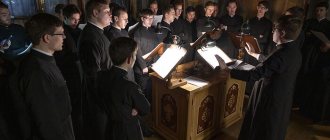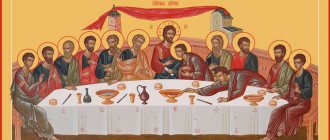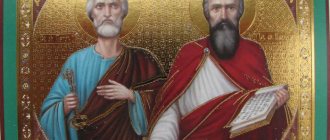An altar boy is a server at the altar.
An altar boy or altar server is the name given to a male layman who assists the clergy at the altar during divine services. This term is mentioned in the Bible (Joel 1:13).
Became generally accepted by the end of the 20th century in most European dioceses of the Russian Orthodox Church. Before this, the Old Russian language had the word “oltarnik”. It meant a priest or a clergyman in general.
Altar of the Church of the Dormition of the Mother of God in Olkhansk. An altar attendant assists a priest in the altar of a church during a service.
The Russian Orthodox Church has adopted a Typikon, in which the person performing the duties of an altar server is called a paraecclesiarch or censer burner.
In ancient times, an altar boy was understood as a sexton, and his duties were often performed by a psalm-reader or sexton, reading and singing at the service.
In our time, the altar boy performs the functions of a priest - sexton and paraecclesiarch, as well as a reader - sexton and psalm-reader.
Until the 19th century, the word “altar boy” was used to describe priests.
Until the 19th century, the word “altar boy” was used to refer to the priests themselves, that is, the servants of the Altar of the Lord. In our time, these are persons who have a decree from a bishop or consecration. If there is no such consecration, no person has the right to put on the altar boy's robes and enter the altar.
Altar workers of the Temple of the Prophet Elijah in Porechye, p. Ilyinskoe. In the Russian Orthodox Church, the altar boy is called a paraecclesiarch or censer burner
It should be noted that in our time the positions of reader and altar server in large parishes differ significantly. Even the fiscal authorities of the USSR, when collecting income taxes, took a tax from the rates of readers as priests, and from altar servers as workers.
In monasteries, the duties of an altar server are usually performed by designated monks with the blessing of the abbot. During bishop's services these are subdeacons.
Early Christianity
In the early Church, before someone could become an altar server, they had to be tonsured. Nowadays, in many places it is not necessary to be tonsured before one is allowed to serve, since the tonsure must be performed by a bishop or priest of higher rank. The altar server and its functions described above have actually changed little over the 2000 years of Christianity and vary little between different churches. In some traditions, such as Greek Orthodoxy or Melnik Catholicism, customs allow for tonsured altar servers to also live in the ararion, wearing symbols of a cross on the back, like the subpolyacon, but with the ends hanging parallel in front. In Russian Orthodoxy, however, the orarion is not usually worn by altar servers, but only by duly ordained subdeacons and deacons.
Any lay person can become an altar server
Many believers ask: how to become an altar boy in a church? First of all, for this it is necessary to understand the importance of such service.
The fact is that from a theological point of view, the altar server, like all other servants of the Altar, is an image of the heavenly world or the Kingdom of God.
In the process of his obedience, he is like the Angels and will serve Christ the Savior to save people (primarily representatives of the local church community) from sin.
The altar attendant of the Church of the Transfiguration of the Lord in Bogoroditsky is schema-nun Gregory (Billim). Usually the altar servers are men, but in some cases this obedience can be performed by a woman
Typically, lay men are elected to the position of altar server. During the years of Soviet power, when altar servers were in short supply, women were allowed to fill this position. In addition, to receive the priestly rank, obedience as an altar server is mandatory.
In the USSR, women were sometimes appointed as altar servers due to the shortage of male believers.
Since an altar boy is admitted to the Altar, he must be a person of high morality and lead a spiritual life.
The fact is that without internal prayer and without struggling with one’s passions, it is impossible to serve at the throne of God.
In addition, the altar server must be humble, attentive, responsible, and clean.
Video: Man before God. Worship. The film tells about an Orthodox service.
The altar server is not a priest, but he is obliged to know the liturgical charter, Church Slavonic language, and the doctrine of the Orthodox Church.
Without fail, he must know the church charter: the rules of worship, the Church Slavonic language, the doctrine of the Orthodox Church.
The altar server is not a priest, but must lead with the laity in the church in an appropriate manner. In some churches, before placing a layman on the altar, the bishops ask the candidate to pass a short exam.
In Catholicism
The practice, confirmed by Pope Benedict XIV in 1775, of excluding women from serving as priests at the celebration of Mass, is not currently observed. In 1994, the Congregation for Divine Worship and the Discipline of the Sacraments clarified that, in accordance with the revision of the 1983 Code of Canon Law, the service of the altar should be considered one of the liturgical functions (lector and cantor), which, according to canon 230 § 2 of the 1983 Code of Canon Law, may performed by people of both sexes.
At the same time, the Congregation indicated that this canon of the Code of Canon Law is only permissive and does not oblige the admission of female altar servers, whose official duties, in essence, are no different from the functions of boy altar servers. In 2006, the only American diocese that excluded women from altar services was in Lincoln, Nebraska. Even where the bishop does not restrict the permission granted by general canon law, the priest in charge of the church is not obliged to comply with it. Traditionalist Catholic groups such as the FSSP and the Institute of Christ the King and some individual priests, for example, do not do this.
Altar servers are supplied by the bishop and wear a surplice
The altar server, according to the 69th rule of the VI Ecumenical Council, is appointed by the bishop according to the rank of reader. In addition, this can be done according to the rank of a priest.
The existing practice in the Russian Orthodox Church, when obedience by an altar boy in a particular church is carried out with the blessing of its rector, is justified by the 14th rule of the VII Ecumenical Council.
Since he participates in worship as a reader, the candidate for this position must have voice and musical abilities.
Orthodox surplice. In most cases, the altar boy wears a surplice, but sometimes he may simply dress in formal, modest clothing.
In most cases, the altar server dresses in a surplice. This is the liturgical vestment of priests and clergy. The sexton's surplice is straight, long with wide arms. Its normal color is white.
In some cases, the surplice is put on a cassock. At the same time, there is an unspoken rule according to which only those who have the blessing of the bishop can wear a cassock.
Altar boy's age
The minimum age depends on local circumstances, but boys must be mature enough to perform their duties without violating the sanctity of the altar. Although it is common in North America for boys to serve as altar servers in church, in some places the practice is virtually unknown and these duties are performed by adult men. In other monasteries, where altar servers are traditionally boys, adult men are not allowed to take on this role.
Some shrines stipulate that boys are not allowed to serve on the altar once they reach adolescence on the grounds that the young man is no longer young enough to serve on the altar.
The duties of an altar server are extremely varied - 5 parts
The responsibilities of a sexton-altar boy are very varied. They can be divided into five parts:
- Preparatory work before the service. This includes: preparing clothes for priests and deacons, lighting lamps on the iconostasis and in the altar. In addition, the altar server prepares the censer, prosphora, wine, water, heat, candles, table, etc. before the liturgy.
- Participation in divine services as a priest and sexton. During entrances, the sexton-altar boy carries a candle and sometimes a censer. In addition, he also supplies the clergy with everything they need at the right time during the service, and rings the altar bell.
- Participation as a reader in worship. The altar server needs to know Compline, the Hours, the Midnight Office, pictorial readings for reading them during Vespers and Matins, as well as the canon, kathismas, six psalms, etc. He can also be entrusted with reading the Apostle at the liturgy.
- Singer, bell ringer and other functions. Read the note and synodnik during the communion of the laity, give the priest a cloth to wipe his lips.
- Cleaning the altar.
Cleaning the altar of the house church of the Holy Martyr Tatiana at Moscow State University.
Lomonosov. Cleaning the altar is one of the main duties of the altar attendant. Thus, by undergoing obedience in the Altar, a lay person perfectly studies the peculiarities of the order of worship in the Orthodox Church. That is why obedience to an altar server is a mandatory step for ordination to the priesthood.
Subordination and prohibitions
Altar servers, regardless of age or gender, are subject to all the normal restrictions imposed on low-ranking clergy. Anyone who is bleeding or has an open wound cannot approach the altar. They cannot touch the altar table or anything on it under any circumstances without a blessing. They cannot touch the sacred vessels, the cup and everything else. They cannot stand directly in front of the altar table or pass between it and the iconostasis, but must cross the altar if they need to move to the opposite side. Control of discipline among the “altar boys” is the responsibility of the senior altar boy.
During the service, the altar server performs more than 25 actions
The responsibilities of an altar server at the liturgy are very extensive. Their approximate number is 25. For example, he must light the lamps and prepare the wine. Making wine involves testing whether it has turned sour. In addition, notes are brought to them at the altar.
Commemorations are read with the blessing of the priest during promiskomedia, as well as in free time before the Cherubim Prayer.
Video: Liturgy with explanation of the Holy Fathers. The film describes the order of the service and the duties of the altar servers participating in it.
At the end of the promiskomedia, it is necessary to bring the censer for censing at the sign of the priest. To do this, lift it with your right hand. The left hand holds the lower cup so that the upper part does not interfere with holding the cover over the censer. Then the cup is lowered to cauterize the large cover. After this, the antidor is cut.
The approximate number of duties of an altar server during a service is 25.
After the start of the fumigation, the sexton must open the curtain over the royal doors and close it after the Great Exit. Before the start of the liturgy, he turns on the chandelier.
During the Small Entrance, before the 3 antiphons begin to be chanted, the sexton lights a sexton candle in a high place. The altar boy himself stands next to the candle.
A chandelier in the Church of the Transfiguration of the Lord in the New Valaam Monastery. The altar boy lights or turns on the chandelier before the start of the liturgy
While singing “Blessed Mercy,” the altar boy-sacristan synchronously crosses himself and bows to the priest. Then they follow the priest from the throne to the high place and bow to him.
They go with a candle to the northern door of the altar and after the priest has passed the high place, they open them and allow him to go out.
After receiving the blessing from the priest, the altar boy enters the southern gate and places the candle back on its high place. After he makes the sign of the cross and bows to the priest, the candle is extinguished.
Canonical subtleties
Before beginning his duties, the altar server must lay down his sticharion and bring it to the priest so that he can bless it. The priest blesses and places his hand on the folded sticharion. The altar boy kisses the priest's hand and the cross on his vestment. Any altar server who has not been tonsured must remove the sticharion when he receives Holy Communion, because all clergy, regardless of rank, receive Communion in accordance with their order in the Church. Before leaving the service, he must receive the blessing of the priest, because following all the formalities is also the responsibility of the altar boy.
An altar server participates in the ceremony of apostolic readings
During the apostolic readings, the altar boy also serves the priest. When the Trisagion is sung, he holds the Apostle vertically in front of him, takes the blessing and with the words: “Bless the Lord, the holy Apostle read,” he goes out.
During the reading of the Apostle, the servant must be given a censer.
Video: Reading the Apostle. The author filmed the process of reading the Apostle by the altar boy during the service.
When verse 1 of the Alleluaria is sung, he needs to take the candle to the pulpit. After the Small Exit, the candle is left burning in front of the icon of the Savior. After verse 1 is read, a candle is placed in front of the pulpit. After the priest reads the Holy Gospel, the candle is brought into the altar and extinguished.
In the case when a special and funeral eketinia is pronounced, the altar server distributes the ordered remembrances among the clergy serving the liturgy. If there is a funeral litany, it is necessary to serve a censer.
The fact is that during this action the priest censes the throne with his back to the open royal doors.
Women's question
In general, women do not serve at the altar, except in nunneries. In this case, they do not receive clerical tonsure (although they must be tonsured nuns) and do not put on the sticharion, but continue to attend services and serve at some distance from the actual altar table. Usually only senior nuns can serve at the altar.
The Great Entrance is the most important part of the service for the altar server.
After the priest reads the secret prayer “No one is worthy...”, the sexton gives him a censer for censing the altar and iconostasis.
While he censes the iconostasis on the sole, it is necessary to light a candle. After finishing the censing, you need to pick up the censer.
Blessing for reading books during worship. Before reading liturgical books, each time the altar server must receive the blessing of the priest.
Next, when the priest reads “Like the Cherubim” 3 times, the altar boy approaches the altar with a censer. It is given to the priest. In the case when the sexton participates in the service alone, he takes the censer in his right hand and takes a candle in his left.
After this, he goes out onto the sole and stands in front of the pulpit. As soon as the priest places the Gifts on the throne, the altar boy enters the altar, places and extinguishes the candle, and holds the censer high to burn the cover.
If the altar server participates alone in the service, he holds the censer in his right hand.
To the exclamation “Let us love one another,” they approach the curtain to open it. When shouting “Doors, doors,” the curtain opens. While singing the Creed, the altar boy boils the kettle.
After the consecration of the Holy Gifts, while singing “We sing to you...”, the altar server bows to the ground and hands the priest a censer for censing the Holy Gifts.
A kettle for boiling water, used in worship. Presenting it to the priest is one of the duties of the altar server.
Next, the curtain closes and the priest is presented with a teapot of boiling water on a tray. A candle is immediately placed in front of the Royal Doors.
As a reader, the altar server, after finishing the singing, reads prayers for Holy Communion. Then, at a sign from the priest, he opens the curtain and moves the candle to the icon of the Savior.
He also holds the cloth and wipes the mouths of the communicants. In the event that the Holy Gifts fall on the plate, the altar server’s task is to prevent them from falling to the floor. After the laity has received communion, he must be given a censer to burn the altar. Later the altar is censed.
Items used in worship. The altar server must know their purpose perfectly
In the final part of the service, the sexton lights a candle on the altar. Then he takes the censer and again gives it to the priest in front of the altar. Before the transfer of the Holy Gifts, the candle is taken away from the pulpit and the antidoron is distributed.
The altar boy reads prayers of thanks, and the priest is given a kettle of warm water to wash the Chalice.
The point is this
The term "altar boy" is sometimes applied to altar servers, but more precisely it means "installed assistant." In the General Instructions of the Roman Missal, the term “altar server” is interpreted as different from the term “minister,” and the duties of the altar server are also different.
If a priest celebrates a Mass in which the congregation does not assist him, he should not do so without an altar boy unless absolutely necessary.
In the absence of established assistants, some of their functions at Mass may be performed by altar servers.
The altar server's duties include keeping liturgical books for the priest when he is not at the altar and reading the main prayers. They bring and store items such as books, vessels, water and lavab towels, vessels for storing blessed bread and microphones.
How to properly present a censer to a priest can be found on the Altar Brotherhood website
Altar brethren - a site about Christianity in the modern world
Since obedience to an altar server is hard physical and spiritual work, the Brotherhood of Altar Servers website was created to help sextons.
On the site you can find, among other things, a Practical Guide for Altar Servers. The altar brethren will tell you, for example, how to properly serve a censer to a priest. To do this, you need to hold the ring with your right hand, and with your left pull out the chain of the lid and clasp all the chains.
Providing the censer to the priest is also the responsibility of the altar boy. The censer is presented to the priest on the right side of the Holy Altar
Also, the altar server is obliged to very carefully ensure that the censer does not go rotten. To do this, you need to prepare coal for it in advance. The censer is served to the priest or serving deacon on the right side of the holy altar.
The censer is presented to the priest on the right side of the holy altar.
The altar server's guidance can also protect the sexton from fatal mistakes. It reminds him that touching the throne and the altar is forbidden to everyone except the priest.
In addition, such a ban also applies to the passage between the throne and the Royal Doors. It is also strictly forbidden for a non-priest to leave or enter through the gates.
In church, the altar server's behavior should be modest. How to achieve this and how to comply with all the requirements for sextons can be discussed on the site’s forum. For example, here you can clarify the order of reading prayers or find out other aspects of the service.
Video: About chatter at the altar. Priest Maxim Kaskun. The author talks about the rules of conduct for altar servers in the altar, pointing out the modesty and restraint of their conduct.
In any case, the altar server must actively communicate with the rector of the temple and the bishop who installed it. The fact is that a particular parish may have its own traditions and subtleties of worship. Only the clergy can know about them.
If the altar server forgets about this, he risks getting into a very difficult situation, violating the very strict rules of worship. This will be followed by punishment, which will be imposed on him by the bishop or rector of the temple.
Preparing gifts
One or more altar servers whose duties include any work in the church that contributes to assisting in the organization of the priest's altar (in the celebration of Mass without the participation of a deacon, the priest performs the functions assigned to the deacon). If, as appropriate, the bread and wine for the Mass are presented by the faithful, the altar servers assist the priest or deacon who receives these and perhaps other gifts to carry them and place them in the appropriate places, such as the altar. They present mugs of wine and water to the priest or deacon to pour into the cup.
If incense is used, the altar boy gives it to the priest, who blesses the gifts, cross and altar, after which the deacon or altar boy bless the priest and people. When the priest washes his hands after this procession, standing at the side of the altar, the altar boy pours water for him.
In Anglicanism
In Anglican churches such as the Anglican Church of Great Britain, the Episcopal Church of the United States, the Church of Wales, and the Scottish Episcopal Church, altar servers are often called assistants and can be either gender or any age (though usually no younger than ten years of age).
The altar boy, his duties, form and status vary in different churches. However, among Anglicans (as among Catholics and Orthodox), he may assist in worship by carrying a cross during a procession, lighting candles, holding a book of the Gospel, holding candles or "torches", assisting a deacon or priest, waving a censer or spraying incense, giving plates for receiving communion and performing many other tasks that the priest or assistant thinks needs to be done.
In Anglo-Catholic churches, assistants usually wear a cassock and a kota. The belt can be a twisted rope with knots at the ends, fastened around the waist. The belt can be white or black. The wearing of crosses or other special pins or symbols is the prerogative of each individual church.
In some more "traditional" parishes, altar servers are evaluated as they develop their ability to serve: trainees, junior assistants, senior assistants, and emeritus assistants. In other cases, the functions of assistants are performed without vestments by persons from the ward who have no formal education, experience, or training.
Altar Boy's Prayer (Yuletide Story)
On Christmas Eve, after reading the Royal Hours, the protodeacon lamented:
What kind of obsession is this year? Not a snowflake. When I think about it, tomorrow is Christmas, but there is no snow, no festive mood.
It’s true,” the rector of the cathedral agreed with him, “they fly into space, so they tore up the sky, the whole weather was mixed up.” Whether it’s winter or something else, you don’t understand.
Altar server Valerka, who was listening attentively to this conversation, timidly interjected:
And you, honest fathers, would pray that the Lord would give us a little snow.
The rector and protodeacon looked with bewilderment at the always quiet and silent Valery: why did he become bold? He immediately began to earn money:
Sorry, fathers, I just thought so,” and quickly ducked into the “sexbox.”
Prayer of the altar boy Valerka
But remembering something, he frowned and, standing up decisively, headed again to the “Quick to Hear” icon. Approaching, he said in all seriousness:
This is what I thought about, Most Holy Theotokos, Father Protodeacon is a kind man, he gave me a ruble, but with that ruble he himself could have bought candles or something else. You see, Holy Mother of God, he is now very upset that there is no snow for Christmas.
The janitor Nikifor, for some reason, on the contrary, is happy, but the archdeacon is upset. I want to help him. Everyone asks You for something, but I always have nothing to ask for, I just want to talk to You. And today I want to ask for the archdeacon, I know that you love him yourself.
After all, he so beautifully sings for You “To my Most Blessed Queen...”.
Valerka closed his eyes and began to sway in front of the icon to the rhythm of the chant motif he remembered. Then, opening his eyes, he whispered:
Yes, he himself would come to you to ask, but he has no time. You know, he has a family, children. But I have no one except You, of course, and Your Son, our Lord Jesus Christ. You yourself ask God to send us a snowball.
We don’t need much, so that by the holiday it will be as white as in the temple. I think that God will not refuse You, because He is Your Son. If my mother asked me for anything, I would gladly do it for her. True, I don’t have one, everyone says that I am an orphan.
But I think that I am not an orphan. After all, I have You, and You are the Mother of all people, as the Bishop said during his sermon. And he always says the right thing. Yes, I guessed this myself. Just ask me for something, and I will definitely do it for you.
If you want, I won’t buy such expensive ice cream, but I’ll buy cheap, milk ice cream for nine kopecks.
He turned pale, lowered his gaze, and then, looking up at the icon, said decisively:
Mother of God, tell Your Son, I won’t buy ice cream at all, as long as it snows. Oh please. You do not believe me? Then I’ll go get some candles right now, and You, Most Holy Theotokos, go to Your Son and ask us for some snow.
Valery stood up and went to the candle box, full of determination. However, the closer he came, the less determined he remained.
Before reaching the counter, he stopped and, turning, walked back, clutching the remaining change in his sweaty palm. But, having taken a few steps, he turned again to the candle box.
Approaching the counter, he nervously walked around it, making mindless circles. His breathing became rapid, and sweat appeared on his forehead. Seeing him, the candle maker shouted:
Valerka, what happened?
“I want to buy some candles,” he said, stopping and saying in a fallen voice.
Lord, come on over and buy it, otherwise you’re walking around like a pendulum.
Valerka looked sadly at the icon case with the “Quick to Hear” standing in the distance. He approached, poured the change onto the counter and said in a voice hoarse with excitement:
For everything, ten kopecks.
When he received seven candles, his soul became lighter.
Prayer for the vestment of the surplice
On September 19, the Orthodox Church celebrates the day of the altar boy or the day of the sexton. Today we want to tell you more about this day and tell you about who the altar boy is.
– Golden (yellow) of all shades (Royal color).
Days of remembrance of prophets, apostles, saints, equal to the apostles, and other ministers of the Church, as well as blessed kings and princes, and on Lazarus Saturday (sometimes they also serve in white).
Golden vestments are used at Sunday services, as well as on most days of the year, unless someone is being commemorated.
Holidays: Nativity of Christ, Epiphany, Presentation, Transfiguration and Ascension, Lazarus Saturday (sometimes also served in yellow), ethereal heavenly powers, and also at the beginning of the Easter service. White vestments symbolize the light that shone from the tomb of Jesus Christ at His Resurrection.
White vestments are used during the sacrament of baptism, weddings and funeral services, as well as when vesting a newly ordained person in the priesthood.
– Blue (the color of the highest purity and purity).
Theotokos holidays: Annunciation, Placing of the Robe, Dormition, Nativity of the Blessed Virgin Mary, Intercession, Introduction, days of remembrance of the Theotokos icons.
The robes of metropolitans are of various shades of blue, even blue.
Cross Worship Week of Lent; The origin (wear and tear) of the honorable trees of the Life-giving Cross of the Lord; Exaltation of the Holy Cross.
Episcopal and archbishop's robes, as well as award skufiyas and kamilavkas, are purple.
– Red, Dark Red, Burgundy, Crimson.
The color of holidays and days of remembrance of martyrs. Maundy Thursday.
At Easter - the joy of the Resurrection of Christ. On the days of remembrance of martyrs - the color of the blood of martyrs.
– Green (the color of life-giving and eternal life).
Holidays and days of remembrance of saints, ascetics, holy fools, the holiday of “The Entry of the Lord into Jerusalem”, the Day of the Holy Trinity.
The robe of the patriarch is green.
– Dark blue, Purple, Dark green, Dark red, Black.
The color of fasting and repentance. Great Lent.
Black is used mainly during the days of Lent, on Sundays and holidays of which the use of vestments with gold or colored trim is allowed.
Example: the feast of the prophet Elijah - served in golden (yellow) vestments.
More information about priestly vestments can be found on our website in the “Sunday School” section on the “About Church vestments” page.
Daily cycle of services.
Please note that the links on our website are burgundy and without underlining - to clarify, hover your cursor over the text.
Altar Server Responsibilities
1. The sexton is obliged to come to the temple before the service in order to prepare everything necessary for the service.
We invite you to familiarize yourself with: Saint Thaddeus prayer for nine days
2. The sacristan must monitor the progress of the Divine Service and reverently perform his duties on time.
3. Before making this or that movement in the altar during the Divine service, the sexton is obliged to think through the order of his actions so as not to make unnecessary movements and thereby not distract the primate and those serving at the altar.
4. Before the evening service, all vestments of the altar are checked and the priestly vestments are changed to the required color if necessary. The altar boy only changes the Veil and Analogers (if any), prepares the airs and shrouds of the required color, and also prepares the priestly vestments of the desired color and also changes the surplice for himself to the desired color.
5. Before the start of the service, sextons must clearly distribute their responsibilities. The sexton preparing the censer makes sure that it is ready on time. This is necessary in order not to delay the deacon (or priest) and not disrupt the course of the Divine service.
6. Prepare Liturgical prosphora, there should be 5 of them (Agnichnaya - the largest, Theotokos - with the image of the Virgin Mary, Nine-part - also large and two more - health and funeral (they are smaller). More details about the prosphora can be found on the page "Proskomedia" //hramiliya1787.ru/index.php?page=proskomidiya.
7. Prepare wine for the Liturgy (if the wine has just been opened, then you need to pour a little holy water into it, if the priest does this himself, then you need to prepare holy water in a ladle).
8. Check all candles used for the Divine Service (so that all have burnt wicks).
9. Always ready-made food is served to the deacon or priest. (The deacon’s right hand (hand) is not kissed (not kissed)). The finished censer is a censer with a burning coal in it, on which incense lies neatly (if the coal has been lying there for a long time, and the top side has burned out, it will be enough to turn it over to the back side - it will flare up like new).
10. It is necessary to ensure that there is always a small spoon in the incense container.
11. The adilo is served and taken from the deacon in the High Place (with the left hand), having previously crossed himself and bowed to the High Place, the primate and the deacon.
12. About the opening of the Royal Doors: one sexton approaches the Royal Doors from the north side, the other from the south, and, slowly, they open at the same time. They approach the High Place, cross themselves, bow to the east, to the primate and to each other (during the bishop's service, it is not the sextons who open the Royal Doors). We invite you to read: prayer to Panteleimon the healer
13. Read the notes with diligence and reverence after the blessing of the priest. After reading, the notes are folded upside down so that it is clear that they have been read.
14. Keep washing utensils clean and tidy, change towels in a timely manner.
15. The senior sexton monitors the availability of supplies of incense coal, incense, lamp oil, etc., which are necessary for worship. Informs the abbot in advance of the need to replenish supplies.
16. Prepare and change the vestments of priests, the altar and shrouds in a timely manner.
17. Change or place the festive icon in the temple in a timely manner.
18. Before major holidays, “general” cleaning is usually done, to which is added the cleaning of the seven-candlestick, candlesticks, censer, chandelier, replacement of candles, preparation of vestments for the altar, and plus simple cleaning.
Tikhar is a long liturgical vestment for priests and clergy with an opening for the head and wide sleeves; it is also worn by subdeacons. The right to wear a surplice can be given to both psalm-readers and laymen serving in the church. The surplice or surplice is the common vestment of clergy.
In terms of time of origin, the surplice is the most ancient garment. For deacons and lower clergy, this is the upper liturgical vestment; for priests and bishops, the surplice is made wider and more spacious than the deacon’s and is called the sacron, over which other vestments are put on. The surplice symbolizes the clothing of salvation and is made from light-colored material.
On the sleeves, shoulders and hem of the surplice, stripes of colored material or brocade are sewn, which symbolize the bonds binding the Savior being led to judgment, the bloody sores He received during torture, and the yoke or yoke of Christ, which the ministers of the church bear. A cross is depicted on the back, symbolizing the Cross that the Savior carried on His back to Golgotha.
The blessing for vesting in the surplice is taken at the beginning of each service. Before blessing the surplice, the altar server places the folded surplice on his left hand and, turning towards the High Place, makes two signs of the cross.
Then he approaches the serving priest (at this time the surplice lies folded on his left hand, and the right hand lies on top of the surplice, as we take a blessing) and takes the blessing with the words: “Bless the Master (meaning the Lord) this surplice,” then, turning again to To the high place, makes the third sign of the cross, kisses the cross sewn on the back of the surplice and reverently puts on the surplice.
Folding the surplice
1. Place the surplice on your back with the sleeves unfolded.
2. Fold the left side of the surplice from the shoulder to the right (the sides are given conditionally, this is not important).
We invite you to read: Prayer for Trinity Parent Saturday
3. Fold the sleeve in half.
4. Fold the right side over to the left.
5. Fold the sleeve.
6. Fold the folded surplice in half (hem to collar).
7. Fold the pieces again. It turns out like this.
8. Turn the surplice over with the collar facing up. You can take it and go under the blessing. After the blessing, one kisses the cross on the back and dresses reverently.
HISTORY OF THE STUFF
In ancient times, vestments similar to the surplice were known under such names as, for example, alba, tunic. All of them meant the usual lower clothing worn by men and women in ancient times.
The surplice was used in all ancient churches. In ancient times, the surplice was made from flax and was white, as indicated by one of its names - alba (white).
The surplice symbolizes the bright life of those dressed in it, personifies purity and innocence.
The cassock is the lower vestment of the Orthodox clergy - a long garment reaching to the toes with long narrow (unlike a cassock) sleeves. It is used not only during worship, but also outside it. During church services and at official receptions, the cassock must be black, but on vacation, at home, and during economic obediences, cassocks of any color are allowed.
There are several varieties of cassock cut (Greek, Russian, etc.): the cut can be to the bottom or only to the waist, both on the right and on the left, the collar can be fastened with an overlap, or can only be grabbed with hooks, it can have additional pockets on the chest, it can have pockets only on the sides, or maybe without pockets at all, etc.
Most often, a cassock is a long, toe-length robe with a tightly buttoned collar, narrow sleeves, sewn in at the waist, slit from top to bottom, with an extended bell at the bottom. The left lower floor goes deep inside under the right upper floor. The oblique upper right floor is fastened on the left side at the neck and in the belt.
You can take a blessing to wear a cassock from the rector of the church, BUT you can serve in a cassock only in your church and not at a bishop’s service.
A blessing from the bishop to wear a cassock is taken only if the rector of your parish blesses you to approach the bishop with this request. After the bishop's blessing, the altar server receives the right to wear and serve in a cassock everywhere.
All of the above happens with the knowledge and blessing of the confessor, and not arbitrarily.
Source: //122plus.ru/molitva-odeyanie-stikharya/










